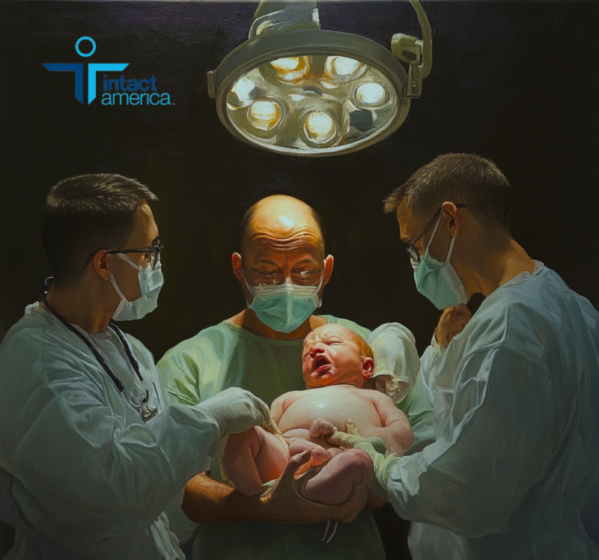
Let’s get one thing straight: Circumcision isn’t just a “harmless little snip.” It’s a brutal practice that robs babies of their right to bodily autonomy and leaves a trail of trauma and regret in its wake. But you wouldn’t know that from the media, which has sold us a fairytale of health benefits and cultural norms while glossing over the real damage being done.
Georganne Chapin doesn’t mince words in This Penis Business: A Memoir—circumcision is “a cruel, unnecessary act disguised as care.” Marilyn Milos’ Please Don’t Cut the Baby! A Nurse’s Memoir goes further, slamming it as a violation of the most basic human rights.
And they’re not alone. Parents, activists, and survivors are speaking out, begging us to see what’s really going on.
I. Media’s Role in This Mass Deception
Mainstream media has become the ultimate accomplice in this act of violence. Instead of shining a spotlight on the irreversible harm circumcision causes, they push a sanitized narrative. The media paints circumcision as just another normal part of life, something that good, responsible parents do for their children’s “health and hygiene.” It’s a classic bait-and-switch: sell the public on “protection” while ignoring the blood, the trauma, and the scars—both physical and psychological—that last a lifetime.
A study published in Public Health Reviews (2013) examined how the media represents circumcision. It found that media coverage often reinforces circumcision as a cultural norm, emphasizing supposed health benefits while rarely discussing the associated risks or ethical concerns. The study argued that media narratives frequently ignore voices critical of circumcision, effectively marginalizing dissenting opinions and promoting a biased, one-sided view.
II. Real Stories, Real Pain
Take Curtis from Worcestershire, who spoke in Caroline Lowbridge’s article, about the nightmare of his circumcision at age 7. “I’m scared of my own penis,” he says, recounting the infection that left him in agony and the years of sex therapy that still haven’t eased his trauma. Or listen to the testimony of countless others who were cut without consent, growing up with anxiety, PTSD, and damaged sexuality—all for a practice that does more harm than good.
And let’s talk about the numbers: A staggering 80.5% of American males have been circumcised, often without any real choice or understanding of the consequences (CDC). And what do they get for it? A lifetime of potential complications and regrets, while the media plays cheerleader to the status quo.
When we say ‘yes’ to circumcision, we say ‘no’ to bodily autonomy, to the right of the child to decide what happens to his own body. Chapin highlights the ethical issue of consent, underscoring that circumcision violates the basic right to bodily autonomy and self-determination.
III. The Unseen Risks and the Myth of Protection
Proponents of circumcision love to cite dubious “health benefits.” They’ll tell you it prevents everything from HIV to… well, whatever fits the narrative. But history has shown us the real story: circumcision was once touted as a cure for everything from epilepsy to masturbation. And now? The same recycled garbage is being peddled to a new generation.
Despite the grand claims, evidence shows circumcision isn’t some magic bullet for preventing HIV. Studies reveal the opposite: a false sense of security that leads to riskier behaviors. It’s like handing out life jackets with holes in them—looks safe, but it’s not saving anyone.
“The scars of circumcision are not just physical; they run deep into the psyche, affecting men in ways we are only beginning to understand.” – Marilyn Milos
Circumcision is not without physical risks. According to a comprehensive review by the Canadian Paediatric Society (2015), complications from circumcision occur in 1-5% of cases, ranging from minor issues like bleeding and infection to more severe problems such as injury to the penis, urethral damage, and, in rare cases, death. This contradicts the media portrayal of circumcision as a risk-free procedure, highlighting a lack of informed consent from parents who are unaware of these risks.
IV. Social Media: The New Battlefield
While traditional media keeps pushing the party line, social media has become a powerful weapon in the hands of those who know the truth. Platforms like YouTube are flooded with videos showing the brutal reality of circumcision, from the anguished cries of infants to testimonies from those who still bear the scars, both visible and invisible.
In 2023, Barry, Murray, Kravvas, Bunker, and Watchorn conducted a cross-sectional analysis of male circumcision videos on YouTube in order to reveal how this practice is portrayed on social media platforms. A whopping 82% presented a neutral or positive view, mainly from healthcare providers. But it’s the 12%—the hard-hitting, anti-circumcision voices—that are turning the tide, exposing the practice for what it really is: genital mutilation.
V. The Raw Reality: We Need to Talk About This
It’s time to stop hiding behind cultural and religious excuses. Circumcision is a human rights issue, plain and simple. When you strip away the euphemisms, the justifications, and the centuries of tradition, what’s left is a barbaric act that has no place in a civilized society.
Male circumcision isn’t just a “procedure”—it’s a form of assault that’s been normalized for far too long. And the media, with its biased portrayals and lack of honest discussion, is complicit. We need to demand better, louder, and more truthful coverage. The voices of those who have suffered should be front and center, not buried in the footnotes of history.
VI. Conclusion
The fight against circumcision is a battle for human rights, autonomy, and truth. The media has the power to change public perception, but only if it chooses to stop pandering to outdated norms and start telling the real story. This isn’t just about circumcision—it’s about every child’s right to a whole, unaltered body. And it’s time we all start acting like it.
Join the fight today because what’s yours should always remain yours.






No Comments